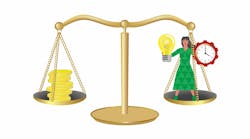Survey reveals how dental assistants help dentists make money
The absence and replacement of any dental team member costs the practice its hard-earned money. One group that’s often overlooked and underappreciated—but costs the practice thousands of dollars in their absence—is dental assistants.
Simply increasing DA pay to meet their worth could work wonders for dental assistant recruitment and retention in practices across the nation. This was proven in a recent survey conducted by the Dental Assisting National Board (DANB) and the DALE foundation.
These organizations have been working tirelessly to elevate the dental assisting profession. They recently formed a workgroup designed to enhance the future of the profession—the Dental Assisting Professional Model Workgroup. The results of another survey conducted recently by DANB indicated that assistants, dentists, and consumers all agree that education and requirements for the profession should be uniform throughout the nation.
But progress can be slow, and assistants are still in short supply due to them departing the profession during the pandemic, or due to low pay, which is the number one reason cited by DAs who leave. This is in spite of the fact that 94% of respondents to this survey indicated that dental assistants make a meaningful impact on practice productivity.
What else did the DANB/DALE survey reveal?
Practices that provide higher salaries for their dental assistants enjoy higher patient retention, higher dental assistant retention, and increased estimated practice productivity.
The cost of constant DA turnover in dental practices is cumulative. Based on a $40,000 a year DA salary, a practice stands to lose a quarter of the DA’s salary in its search to replace them. Part of the outgoing expenses involve advertising and recruiting efforts.
If a dental practice has an open DA position for a full year, it could potentially lose out on nearly $110,000 in revenue and incur $30,000 to almost $60,000 in additional labor cost due to other team members taking on additional tasks. Sometimes it’s even the dentist who takes on the extra burden. This is not time well spent for the highest earning member of the team.
When a dental assistant is out of the office, one in four private practices reports having to decrease or reschedule some patient visits, while nearly half of public clinics report doing so. Half of private practices reassign the DA’s duties, which leads to a 76% increase in daily cost.
What can be done to improve DA retention?
There are ways to change and improve this situation for dental assistants, dentists, and ultimately the entire team: increase DA pay by a suggested 15%. DANB has provided a toolkit and retention calculator to help the dental team determine the costs and returns of the DA based on the practice’s financial information. As an example, they suggest a $6,125 pay increase against the potential loss of $110,000.
Of course, words of encouragement have proven to boost team morale and keep people engaged in their work. There's nothing like a simple "Thank you" or "Good job" to make someone's workday a bit brighter. DAs also appreciate being recognized during Dental Assistants Recognition Week, which occurs the first week in March each year.
This DANB/DALE Foundation survey is part of these organizations’ ongoing efforts to demonstrate the value of dental assistants in the profession. The results show the potential loss of income for a practice, and the value that a dental assistant can have on a practice's production.
View the entire report from DANB and the DALE Foundation here.
A bit of housekeeping: in this survey released by DANB, respondents included dentists, dental office managers, and dental practice administrators from every state, including urban and rural regions. Respondents represented a mix of general and specialty practices, as well as private practices, DSOs, and nonprofit/public clinics. More than 560 responses were received, with a 95% confidence level and a 5%-6% margin of error.









